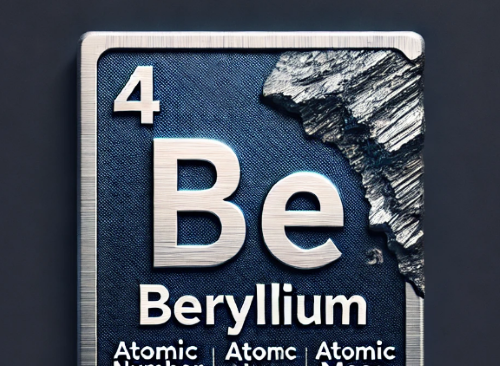
Introduction
Beryllium, a lightweight and high-strength metal, plays a pivotal role in various industries, from aerospace to electronics and healthcare. Yet, beryllium also poses significant health risks when mishandled. Understanding its properties, key applications, and the associated safety considerations is crucial for industries that use this versatile metal.

Properties of Beryllium
Beryllium is a chemical element with the symbol Be and atomic number 4. It is classified as an alkaline earth metal, and its properties set it apart from many other materials used in industrial applications.
- Lightweight and Strong: One of beryllium’s most significant properties is its combination of low density and high strength. It is about one-third the weight of aluminum but much stronger, making it ideal for applications requiring both strength and minimal weight.
- High Melting Point: Beryllium has a high melting point of around 1,278°C (2,332°F), making it suitable for high-temperature applications. This quality is especially important in aerospace and defense, where materials must withstand extreme conditions.
- Excellent Thermal Conductivity: Beryllium is an excellent conductor of heat, which makes it invaluable in applications that require efficient heat dissipation, such as electronics and power generation.
- Non-Magnetic and Corrosion-Resistant: Beryllium does not react with most acids and is resistant to corrosion, even in harsh environments. It also does not exhibit magnetic properties, making it ideal for use in high-precision applications like medical devices and electronic components.
- High Modulus of Elasticity: Beryllium has a high stiffness-to-weight ratio, which means it maintains its shape and resists deformation under stress. This property is essential in aerospace and defense applications where materials need to withstand heavy loads without bending.
Applications of Beryllium
Given its unique combination of properties, beryllium is used in a variety of critical applications across several industries:
- Aerospace and Defense: Beryllium is widely used in the aerospace industry for its lightweight, high-strength characteristics. It is a key component in satellite systems, missiles, and other military equipment. Beryllium alloys are used in structural components, such as precision mirrors, which require strength and the ability to perform under extreme conditions. The metal’s high thermal conductivity also makes it ideal for aerospace components exposed to high temperatures.
- Electronics: Beryllium is used in high-performance electronic components, including connectors, switches, and semiconductor equipment. Beryllium copper alloys, which combine beryllium with copper, are widely used for their excellent electrical conductivity, corrosion resistance, and mechanical properties. These alloys are found in applications like telecommunications, precision instruments, and medical devices.
- Nuclear Reactors: Beryllium plays a critical role in nuclear reactors, where it is used as a neutron moderator. Its low atomic number makes it an effective material for slowing down neutrons in reactors, which is essential for sustaining the nuclear chain reaction. Beryllium’s ability to withstand high temperatures also makes it useful in nuclear energy generation.
- Medical Devices: In the medical field, beryllium is used in X-ray equipment, MRI machines, and other diagnostic imaging devices. Beryllium’s high rigidity and lightweight nature are critical in medical equipment that requires precise movement and stability. Additionally, the metal’s transparency to X-rays makes it an ideal material for components in radiology.
- Precision Instruments: Beryllium’s high modulus of elasticity and lightweight nature make it ideal for use in precision instruments, such as lasers, accelerometers, and optical systems. Its strength and stability allow these instruments to maintain their accuracy even under challenging conditions, such as extreme temperatures or vibrations.
Further reading: 6 Common Uses of Beryllium
Safety Considerations
While beryllium has many advantages, it also presents significant health risks, particularly when it is handled improperly. The primary safety concern with beryllium is its potential to cause chronic beryllium disease (CBD), a lung disease caused by inhaling beryllium dust or fumes.
- Chronic Beryllium Disease (CBD): Prolonged exposure to beryllium dust or fumes can lead to CBD, a condition that causes inflammation and scarring in the lungs. CBD can develop even after relatively low levels of exposure and may not manifest until years after the initial exposure. Symptoms include coughing, difficulty breathing, and fatigue. In severe cases, CBD can be fatal. The condition is preventable with proper safety precautions.
- Beryllium Sensitization: Some individuals who are exposed to beryllium can become sensitized, meaning their immune system reacts to the metal as if it were a harmful substance. Sensitization can lead to CBD even with lower levels of exposure. This makes it crucial for industries working with beryllium to implement protective measures for workers.
- Workplace Safety: To mitigate the risks of exposure, workers handling beryllium should follow strict safety guidelines. This includes wearing protective gear such as respirators and gloves, working in well-ventilated areas, and monitoring beryllium levels in the workplace. Regular health screening and monitoring are also essential for those at risk of exposure.
- Environmental Concerns: Mining and processing beryllium can also have environmental implications. Efforts to manage and reduce beryllium waste and ensure safe disposal are essential to prevent contamination and protect both human health and the environment.
Conclusion
Beryllium comes with a unique set of properties and is invaluable in applications requiring strength, lightness, and stability. From aerospace and defense to electronics and medical devices, its use continues to grow in high-performance technologies. However, the health risks associated with beryllium exposure, particularly chronic beryllium disease, must be taken seriously. For more information, please check Advanced Refractory Metals (ARM).

